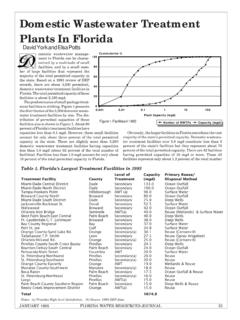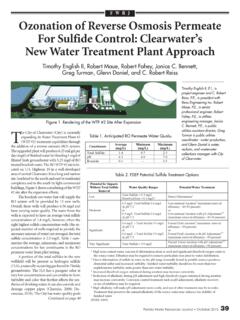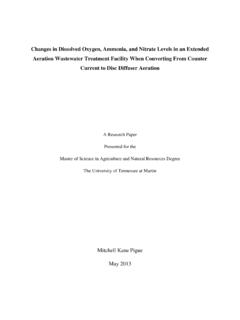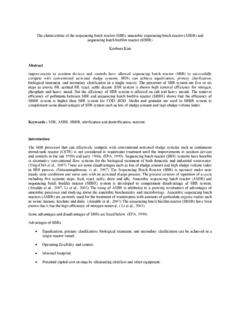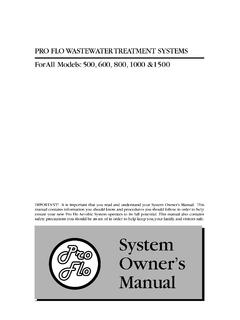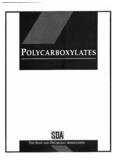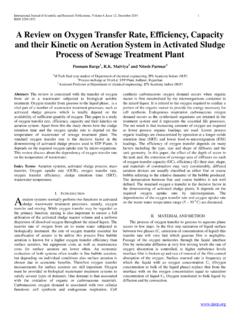Transcription of F/M Ratio and the Operation of an Activated Sludge Process
1 20 MARCH 1999 FLORIDA WATER RESOURCES JOURNALny one of a number of factors can affect overall CBODand TSS removal efficiencies of an Activated sludgeprocess. Some factors are the responsibility of thedesign engineers and are essentially uncontrollable as far asoperations go. These include aeration tankage, settling tanks,flow equalization, return Activated Sludge , aeration supply,waste Sludge handing, and digested Sludge factors affecting efficiencies are functions of the con-nected system, such as daily flow volume and and raw sewageCBOD, and are again uncontrollable by the operator. Thesefactors may vary seasonally, on weekdays, or on there are other factors affecting efficiency that arecontrollable by the operator.
2 These include the food to microor-ganism (F/M) Ratio (which is controlled by the wasting ofbiological growth), proper raw sewage flow equalization, returnactivated Sludge rates, digester supernatant return, digestedsludge disposal, and control of residual dissolved oxygen inaeration tanks (valving of centrifugal blowers, proper sheaveson positive displacement blowers, turning on or off blowers,time switch Operation of blowers).Of these factors that can be controlled by the operator, themost important is the F/M Ratio . The food in the Ratio is theCBOD entering the Process . The microorganisms are theactivated Sludge solids in the aeration tanks, which are mea-sured as ppm or mg/L of establish and maintain a consistent CBOD and TSSsecondary waste removal from raw sewage, an Activated sludgeprocess must maintain the weight of food to weight of microor-ganisms under aeration within the limits of the type of treat-ment being provided by the facility design operators and engineers have never grasped the im-portance of F/M Ratio control.
3 Part of the reason is because of themany different methods of calculating three main methods of controlling Sludge wasting in-clude the F/M Ratio , the Sludge Age method {SA}, and the MeanCell Residence Time method {MCRT}. In reality, these methodsall measure the same thing, and, in fact, the F/M Ratio is merelythe reciprocal of the SA. The MCRT is somewhat more the final analysis, all three methods do the same thing:measure the Ratio of food to microorganisms by weight in theaeration find the F/M Ratio to be the easiest to calculate and theeasiest to understand. MCRT and SA can be confusing becausethey are expressed in days, which many people confuse withcalendar days; they are really only key to understanding the F/M Ratio is that it is not justconcentration versus concentration, it is the weight of food(CBOD) compared to the weight of microorganisms (MLTSS).
4 Volume FormulasTo calculate an F/M Ratio , you must know the volume of waterbeing aerated. The volume of water in a rectangular tank inmillions of gallons is:V = (L x W x H x )/1,000,000(Equation 1)where L= the interior length and width of the tank in feet,W= the interior length and width of the tank in feet,H= water depth in feet, the number of gallons in a cubic foot,1,000,000= the number of gallons in a million volume of water in a round tank in millions of gallons is:V = x (D/2)2 x H x )/1,000,000(Equation 2)Or simplifying, V = ( x D2 x H)/1,000,000 Where = interior diameter of the tank in feet,H= water depth in feet, the number of gallons in a cubic foot,1,000,000 = the number of gallons in a million Pounds FormulaTo calculate the F/M Ratio , both the food and the microorgan-isms must be compared in the form of mass or weight.
5 In the measure usually is in weight, , pounds. Realizing that onegallon of water weighs pounds, the following formulaconverts a flowrate in MGD with a concentration in parts permillion (which, for our purposes, can be assumed to be the sameas mg/L) to a weight in pounds per day:W = ppm x lb/gallon x MGD (Equation 3)where W= weight in poundsFor example, assume that a complete-mix Activated sludgetreatment plant has an average daily flow into aeration of , a CBOD into aeration of 200 ppm, and aeration volume million gallons, and an MLTSS of 2500 weight of food entering the Process , from Equation 3, is200 x x = 1670 pounds per weight of microorganisms under aeration, again fromEquation 3, is 2500 x x = 5210 F/M Ratio is then 1670/5210 = the standard Process F/M Ratio (see accompanyingtable)
6 Is from to , the example Process is within properefficient operating another example, as-sume that the same processduring a seasonal low-flowperiod has an average dailyflow into aeration of , a CBOD into aerationof 170 ppm, and the sameMLTSS as weight of food into theactivated Sludge Process ,from Equation 3, is 170 x = 992 weight of microorgan-isms under aeration, fromF/M Ratio and the Operation of an Activated Sludge ProcessGary Lee MishoeGary Lee Mishoe, CAO, is the utilities director for Lake PlacidActivated Sludge Process Ranges for F/M Ratio ControlProcess Range NamesCommon SWT ASP NamesF/M RangeExtended AerationExtended Lb CBOD5/1 Lb MLTSSS equencing Batch ReactorsRace Track or Orbital DitchStandard Activated SludgeConventional Activated Lb CBOD5/1 Lb MLTSSC ontact StabilizationStep AerationComplete (or Homogenous) MixOthers used with nutrient removalHi-Rate Activated SludgeHRAS based on desired Lb CBOD5/1 Lb MLTSS{75 to 60% efficiency)}
7 FLORIDA WATER RESOURCES JOURNAL MARCH 1999 21 Equation 3, is 2500 x x = 5210 F/M Ratio is then 992/5210 = , whichis below the standard range of to Theprocess has too much Sludge (weight of micro-organisms) under aeration for the food beingprovided. The operator should waste Sludge tolower the MLTSS in Optimal MLTSSThe optimal MLTSS is based on the Ratio -proportion formula, R1:R2::P1:P2, where theproduct of the means is equal to the product, or:(R1 x P2) = (R2 x P1)(Equation 4)where R1= the desired F/M Ratio = for the above the MLTSS corresponding tothe desired F/M Ratio , or for an F/M Ratio optimal MLTSSP1= weight of food in aeration fromEquation 3, or 992 lb/day inthe above , for the example plant: ( x P2) = ( x 992)or, P2 = ( x 992) = 3968 lbs optimal aeration MLTSS concentrationcan be found by rewriting Equation 3 as.
8 Ppm = (pounds per day MLTSS)/( x MG)ppm = (3968 lb/day)/( x MG) = , 1900 ppm is the maximum con-centration of MLTSS to achieve a F/M Ratio number of years ago when I was a youngbuck in the water and wastewater industry, Iwrote some articles on Activated Sludge opera-tion for the Overflow Magazine. I am now an old-timer, but I still see a need for someemphasis on understanding Activated sludgeprocess Operation . nJanuary Water Treatment: Water Distribution. FWPCOAO fficersMarchWastewater Conference Issue. TreatmentJuneFSAWWA & FWEA technical Wastewater/Residuals Resources Management/FWPCOA Awards.
9 Treatment. Calendar22 MARCH 1999 FLORIDA WATER RESOURCES JOURNAL early one million septic tanks were operating inFlorida(1) in 1970. Since then, an average of 48,660 newseptic tanks have been installed in the state each 1984, one of three buildings are constructed with septictanks(2). An estimated million septic tanks are in operationtoday(3) with more than 80 percent in urbanized counties. Ofthose 15 counties with more than 50,000 tanks in Operation , 11have more than 70 percent of their soil conditions that signifi-cantly limit the ability of on-site septic tank drainfields tofunction properly(4). The most common condition is seasonalwetness or shallow that each septic tank handles an average flow of250 gpd, the composite discharge into our state s watershedsand groundwaters is 450 MGD of partially-treated closer to surface and groundwater the discharges are, theless soil treatment is available and the greater the impacts areto water significant number of tanks are not operating under 1983state standards, which set certain treatment presumptionswith horizontal and vertical setback limits to surface andgroundwaters(5).
10 These setbacks ( two-feet vertical clearanceto high groundwater table) allow some removal of nutrients andpathogens. A large number of pre-1983 tanks are installed incoastal communities with high groundwater tables and numer-ous drainageways, have drainfields that are directly within thegroundwater table, and discharge effluent with very post-1983 systems offer a mixed bag of nutrient re-moval. An in-depth study sponsored by the Florida Departmentof Health(6) shows evidence of nitrate impacts and potentialbreakthrough of phosphorus, even with mounded drainfieldsystems, after only six months of effluent dosing. Averagenutrient levels measured at two feet below the drainfieldsystem in this study were as follows:Although organic nitrogen (TKN) is nitrified, denitrificationis not provided by unsaturated soils.

